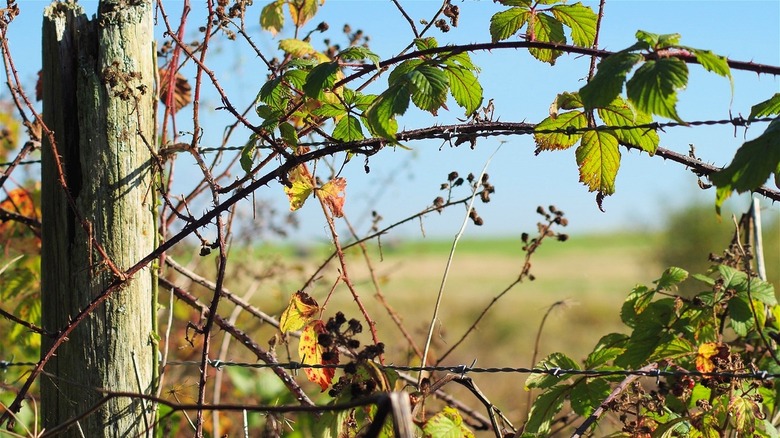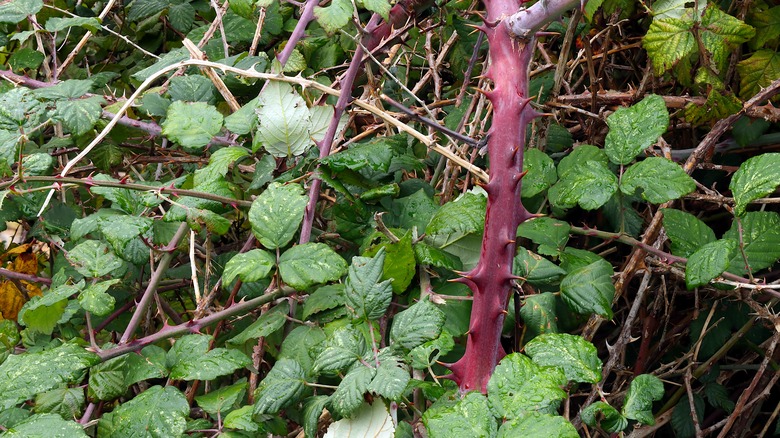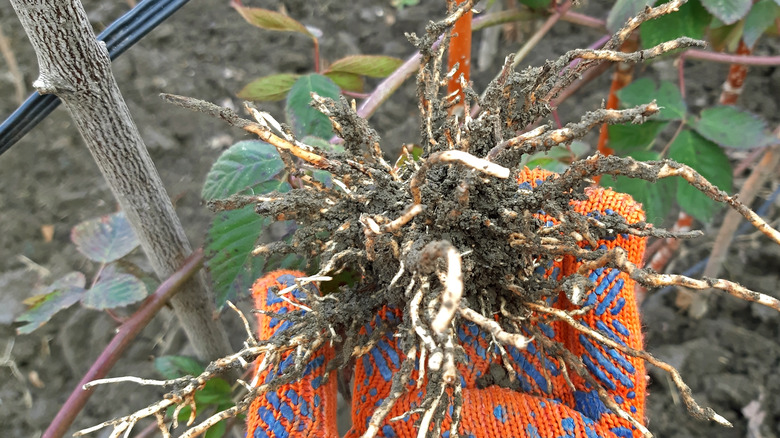The Best Method For Getting Rid Of Thorny Brambles In Your Yard
Trying to eliminate a thicket of prickly brambles can be a thorn in your side. Literally. Even with leather gloves and a thick coat, you could end up with scratches and gashes. While people typically love the berries they produce, the vines can be a hazard and an eyesore. But trying to get rid of brambles — which also include blackberry bushes — doesn't have to be as challenging as you might expect.
To start, make sure that you protect yourself as much as possible. Regular gardening gloves, even ones coated in latex or made with leather palms, may not be enough won't be enough to protect your hands from prickles. You want to wear thick, full-leather gardening gloves to protect your hands as you handle the thorny stalks. Ideally, full-leather gloves that go past your wrists are ideal if you can find them. And make sure to wear thick layers of clothes, like a heavy sweatshirt and a sturdy pair of jeans, to protect the rest of your body.
The first steps in getting rid of your brambles
The first step is to chop back all the vines. A good pair of gardening loppers will be your friend. Loppers are long-handled pruning shears with more power than your regular handheld pruners so that they can get through the woody stalks of old bramble bushes, which can be quite thick. The handles also help to keep your arms protected as you chop down the vines. Ordinary handheld garden shears can also work on thinner plants or new ends. Start cutting at the fresh ends of the plant where they're more malleable, and the thorns are smaller. Ideally, you can chop them into smaller, manageable portions, around 8 to 12 inches, until you get down to the base core of each vine.
Once you have the vines down to a manageable size, you want to dig out all the roots you can find. In that case, investing in a root-digging tool would be a good idea. While not expensive, they're like shovels with a blade on the edge. You could get a Japanese hori hori blade that looks like a narrow garden shovel but has a serrated edge, or go for full-scale sawblade-like shovels meant to get to thicker, deeper roots. A small pitchfork also could work. You might do well with just your hands if you have younger plants, but larger vines will likely need something more substantial to dig out the underground root structure.
Keep an eye on new bramble growth
You might think you're done once you've gotten rid of the existing plants. But sadly, brambles and blackberry bushes are hardy and can regenerate from any remaining roots. They're part of a class of plants that propagate through rhizome division, which are basically sprouts of the plants that branch out from the primary growth. Similar plants with rhizomes include hops and bamboo, both of which can also become invasive. Blackberry bushes also grow back fast, so don't let your hard work and potential skin scrape sacrifice be in vain. Keep an eye on the area where the brambles grew, and be vigilant about digging out any sprouts or new growth as quickly as you can so they don't re-spread.
One other option to look into is a brushwood killer or a stump and vine killer. If you don't like the idea of using pesticides, there are natural remedies available. One such remedy includes combining two parts regular table salt and one part water in a spray bottle and then misting the roots, branches, stems, and leaves with the mixture. Repeat the process daily for 10 days in a row, then remove the unwanted plants manually. This method can be effective for killing brambles in smaller areas. It may not be strong enough, though, for a significant infestation. Still, whatever you use, regular monitoring and maintenance can help you remove these bramble bushes for good.


